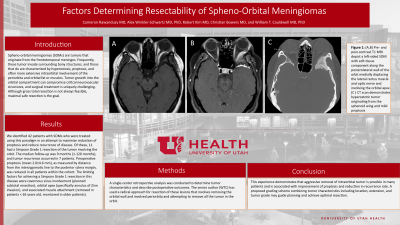Factors Determining Resectability of Spheno-Orbital Meningiomas
Factors Determining Resectability of Spheno-orbital Meningiomas
Friday, April 21, 2023


Cameron Rawanduzy, MD
Research Fellow
University of Utah
Salt Lake City, Utah, United States
ePoster Presenter(s)
Introduction: Spheno-orbital meningiomas (SOMs) are tumors that originate from the frontotemporal meninges. Frequently, these tumor invade surrounding bony structures, and those that do are characterized by hyperostosis, proptosis, and often more extensive intraorbital involvement of the periorbita and orbital fat or muscles. Tumor growth into the orbital compartment can compromise critical neurovascular structures, and surgical treatment is uniquely challenging. Although gross total resection is not always feasible, maximal safe resection is the goal.
Methods: A single-center retrospective analysis was conducted to determine tumor characteristics and describe postoperative outcomes. The senior author (WTC) has used a radical approach for resection of these lesions that involves removing the orbital wall and involved periorbita and attempting to remove all the tumor in the orbit.
Results: We identified 42 patients with SOMs who were treated using this paradigm in an attempt to maximize reduction of proptosis and reduce recurrence of disease. Of these, 11 had a Simpson Grade 1 resection of the tumor involving the orbit. The median follow-up was 9 months (1-120 months), and tumor recurrence occurred in 7 patients. Preoperative proptosis (mean 2.0±4.6 mm), as measured by distance from the interzygomatic line to the posterior sclera margin, was reduced in all patients within the cohort. The limiting factors for achieving a Simpson Grade 1 resection in this disease were cavernous sinus involvement (planned subtotal resection), orbital apex (specifically annulus of Zinn invasion), and associated muscle attachment (removed in patients < 65 years old, monitored in older patients).
Conclusion : This experience demonstrates that aggressive removal of intraorbital tumor is possible in many patients and is associated with improvement of proptosis and reduction in recurrence rate. A proposed grading scheme combining tumor characteristics including location, extension, and tumor grade may guide planning and achieve optimal resection.
Methods: A single-center retrospective analysis was conducted to determine tumor characteristics and describe postoperative outcomes. The senior author (WTC) has used a radical approach for resection of these lesions that involves removing the orbital wall and involved periorbita and attempting to remove all the tumor in the orbit.
Results: We identified 42 patients with SOMs who were treated using this paradigm in an attempt to maximize reduction of proptosis and reduce recurrence of disease. Of these, 11 had a Simpson Grade 1 resection of the tumor involving the orbit. The median follow-up was 9 months (1-120 months), and tumor recurrence occurred in 7 patients. Preoperative proptosis (mean 2.0±4.6 mm), as measured by distance from the interzygomatic line to the posterior sclera margin, was reduced in all patients within the cohort. The limiting factors for achieving a Simpson Grade 1 resection in this disease were cavernous sinus involvement (planned subtotal resection), orbital apex (specifically annulus of Zinn invasion), and associated muscle attachment (removed in patients < 65 years old, monitored in older patients).
Conclusion : This experience demonstrates that aggressive removal of intraorbital tumor is possible in many patients and is associated with improvement of proptosis and reduction in recurrence rate. A proposed grading scheme combining tumor characteristics including location, extension, and tumor grade may guide planning and achieve optimal resection.
